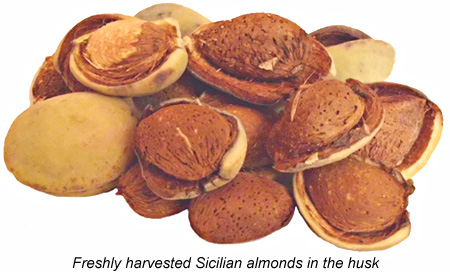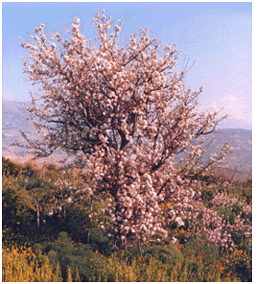...Best of Sicily presents... Best of Sicily Magazine. ... Dedicated to Sicilian art, culture, history, people, places and all things Sicilian. |
by Roberta Gangi | ||
Magazine Index Best of Sicily Arts & Culture Fashion Food & Wine History & Society About Us Travel Faqs Contact Map of Sicily |
In the Bible the almond is variously referred to as shakked and luz (the latter also refers to hazels). The Latin for almond is amygdalus (from the Greek amugdale), which in medieval times became amandolus. The Old French, from which the English word comes, was almande, and the Italian word is mandorlo. The Sicilian word was mandola or mendula. In Sicily almonds blossom in February (in the Middle East they bloom in January), when Agrigento celebrates its Almond Blossom Festival. There are numerous Biblical (Old Testament) references to almond trees, which early in history became symbolic of various virtues and myths. Anciently almonds were cultivated across southern Eurasia, from Spain to Turkey to India to China, and today are widely grown in warmer climates in the Americas. Today Italy is one of the major producers of almonds, surpassed by several nations. Almonds are the world's most widely grown and consumed tree nut.
Almonds symbolise good fortune, and as sugar-coated confetti are given at Italian weddings and baptisms. This custom has become international. (The term "confetti" used to describe bits of multicoloured paper is properly coriandoli in Italian.) In Sicily the association of the almond tree with love and fidelity is rooted in Greek mythology. Phyllis, a noble maiden, wed Demophon, who visited Thrace to wed her after the Trojan War but then departed. Phyllis waited for him to return, but after some years died of a broken heart. An almond tree sprang up at her grave. The tree finally bloomed when Demophon visited the grave of his beloved wife. Centuries earlier, in Judaic history, Samson presented flowering almond branches to attract Delilah. About the Author: Roberta Gangi has written numerous articles and one book dealing with Italian cultural and culinary history, and a number of food and wine articles for Best of Sicily Magazine. | |
Top of Page |
 First
cultivated in the Middle East, the almond was probably introduced
in Sicily before 1000 BC (BCE). There are several varieties of almond (including
bitter and sweet almonds), all related to prunus amygdalus. The idea that
sweet almonds grow from white flowers and bitter ones from pinkish blossoms
is somewhat misleading, at least in Sicily. The almond, which is related
to the peach and plum, is the pit (stone) of a green husk. Indeed, the almond
shell and seed (kernel) resemble those of the peach - also widely cultivated
in Sicily. In addition to the almond nuts themselves, the seeds yield a tasty oil
and certain potentially toxic substances (the cyanides). Almonds are rich
in Vitamin E and are a good source of healthy monounsaturated fats.
First
cultivated in the Middle East, the almond was probably introduced
in Sicily before 1000 BC (BCE). There are several varieties of almond (including
bitter and sweet almonds), all related to prunus amygdalus. The idea that
sweet almonds grow from white flowers and bitter ones from pinkish blossoms
is somewhat misleading, at least in Sicily. The almond, which is related
to the peach and plum, is the pit (stone) of a green husk. Indeed, the almond
shell and seed (kernel) resemble those of the peach - also widely cultivated
in Sicily. In addition to the almond nuts themselves, the seeds yield a tasty oil
and certain potentially toxic substances (the cyanides). Almonds are rich
in Vitamin E and are a good source of healthy monounsaturated fats. The almond tree grows to a height of about 10 metres (30 feet). After
olive trees, almond trees are the most widely grown fruit tree in Sicily,
where there are various, subtly-distinguished varieties. In Roman times,
almonds were cultivated as far north as Normandy and southern England, but
the trees rarely survive a hard freeze, and they produce less fruit in cooler
regions (northern Europe was probably slightly warmer 2000 years ago). Sicilian
almonds are harvested in July, if not earlier. Very few find their way into
the export market. Most Sicilian almonds, like
The almond tree grows to a height of about 10 metres (30 feet). After
olive trees, almond trees are the most widely grown fruit tree in Sicily,
where there are various, subtly-distinguished varieties. In Roman times,
almonds were cultivated as far north as Normandy and southern England, but
the trees rarely survive a hard freeze, and they produce less fruit in cooler
regions (northern Europe was probably slightly warmer 2000 years ago). Sicilian
almonds are harvested in July, if not earlier. Very few find their way into
the export market. Most Sicilian almonds, like